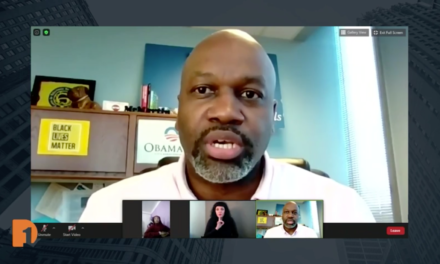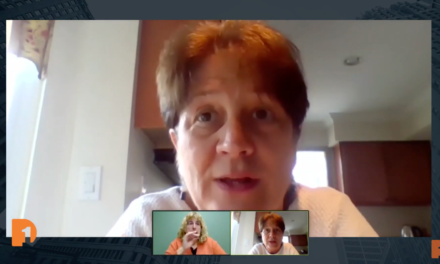In response to the pandemic, Michigan’s public universities made the big transition to online classes in March. In the months since then, these schools have seen their financial streams take a huge hit.
Christy talks with Dan Hurley, CEO of Michigan Association of State Universities, about universities’ financial stability right now, concerns over state funding next year, enrollment, and how the pandemic will affect the delivery model of higher education statewide.
Read full transcript
Christy McDonald We’re all looking forward to what’s going to happen with schooling in the fall, especially looking at our colleges and universities in the state of Michigan, and joining me now is Dan Hurley. He is the CEO of Michigan Association of State Universities and the Coordinating Board really for the 15 public universities in the state of Michigan.
Hi, Dan.
Dan Hurley, CEO, Michigan Association of State Universities Good morning.
Christy McDonald It’s good to see you. You have your hands full right now. Can you give us a sense of where we are now these first weeks of May? What the biggest issues are at the at the universities here in Michigan? Looking forward to the fall.
Dan Hurley, CEO, Michigan Association of State Universities I would say two come to mind, one is just financial stability. The universities are getting hit in every possible revenue stream. The first hit came through the auxiliary enterprises. So, campus housing, dining, bookstores, summer camps, everything that all just came to a complete halt and then refunds were issued in most cases. There are concerns about what might happen with enrollment so far. Summer enrollments seem to be doing pretty good across the 15 universities online. But then there’s certainly a lot of concern about what might happen. All kinds of varying predictions, what might happen with fall enrollment.
And then the other unknown at this moment is what might happen with state funding. Michigan is already a laggard—one of the worst states in the nation terms of investing in higher education and we’re sort of holding our breath and hoping that the other shoe doesn’t drop in terms of state funding for the current year, but alone next year. And the federal stimulus dollars helped out to some degree, but came nowhere clear fully offsetting the huge financial hit that are hitting universities.
And then the other thing I would say is happening, a lot of focus across the universities is really continuity planning going about this incredibly complex and arduous task of planning for the resumption of on-campus classes and activities. And there are just so many variables in that. And so, we’re trying to help shepherd that conversation, recognizing that it all begins with public health and safety. But around that, there are so many other considerations for students, for faculty, staff or visitors and so we’re helping with that conversation.
Christy McDonald And looking at the public health aspect of it and if people feel safe coming back on campus and that really dovetails into the enrollment which goes to your budget. So when you look at if I’m going to be paying for Michigan State University for online classes and living at home, that might make a lot of different decisions for students in whether they even want to enroll at that university for the next year or if they want to stay home and try something different or take a year off. Are you finding or are the universities starting to reach out or are they surveying their students or what? What’s the feedback that they’re getting?
Dan Hurley, CEO, Michigan Association of State Universities Yeah, they’re certainly doing a lot of outreach. One thing that we’ve done, we’ve teamed up with the states twenty five independent colleges and issued a statement. So forty colleges issued a statement a couple of weeks ago, really assuring students first and foremost in their families about flexibility with regard to admissions, making sure that, you know, these interruptions that have taken place at the high school level are not gonna impact admissions decisions.
And then when it comes to what’s going to happen this fall, that’s still up in the air. I think most universities are going to make a formal announcement of what that model will look like, probably late, mid-June to early-July.
Interestingly, as you mention, there are a lot of possibilities out there. The idea of not attending a college, maybe a community college closer to home or when it’s in-state versus out-of-state doing a gap year and skipping it altogether, all kinds of potentials there.
But what I’ve seen from a preliminary basis is that the enrollment numbers are actually looking pretty good right now for deposits. One interesting aspect is while there certainly are health and safety considerations, there’s financial implications in terms of ability for a student family to afford college. This quarantining is creating a lot of pent-up interest in all of us. And so, I think there might be actually a stronger desire to actually head off to a college town or college state.
Christy McDonald You know, you’re representing all of the universities in the state of Michigan. Is there going to be those some kind of competition where you have different universities setting what their goals are going to be for students back on campus or what goes at U of M will go at Michigan State, will go at Western? Is there any kind of tension there versus what one institution is going to do versus another?
Dan Hurley, CEO, Michigan Association of State Universities I think that might have been the case to some degree when all the universities converted to online education and that fateful day in March, it was announced around 10:00 in the morning by Michigan State and by 9:00 o’clock night, 14 other universities had made that transition. I think it’s going to be a little bit different in terms of the resumption of on campus activities and classes by the university, keeping in mind that they are so diverse, whether they’re commuter campuses, largely, whether the residential campuses, whether they’re in urban Detroit or rural Upper Peninsula in Michigan, the size of the community, the campus community, whether they have primarily undergraduate mission or there’s a lot of research involved, there’s so many different factors.
So, I think we have the most market based collection of public universities in the country. I think that’s a good thing. It drives up quality. And I think we’re going to continue to see that independent decision making regarding the resumption of on campus operations. But again, with health and safety being a key component.
Christy McDonald Let’s talk a little bit about budget that we’ve seen some layoffs at universities around the state. Obviously, some universities really rely on athletics to be able to bring in a lot of money as well. And then if you’re not getting a lot of funding from the state, but yet hesitant to raise tuition. Knowing full well that families are going to be hurting right now coming out of this. What does the money situation look like for universities or seven better positions than others? Some were already suffering before the pandemic?
Dan Hurley, CEO, Michigan Association of State Universities Absolutely. Yes. I mean, we’ve been underfunded in this state for a long time. We’ve had enrollment challenges just by way of being an older, graying state where one of the top forecasts forecasters state in the nation in terms of the forecast decline in high school graduates. So that’s already been a challenge. So, yeah, this I would have never thought in my career I would look back at the Great Recession and say that wasn’t a cake walk, but it’s going to make this you know, that was pretty easy compared to this. The universities are getting hit by, you know, at every level. One of the areas, why there is a lot of unknowns with regard to enrollment this fall where there is one greater certainty is that is a huge decline in international students, essentially assuming just given travel restrictions, maybe no new international students in for even the smallest colleges to the largest, it’s all an order of magnitude.
And so that’s not just a hit on those higher paying students for one year. It’s four year cohort. Really? So, it hits that revenue pipeline for several years. So, the universities are in full fledge financial still stability mode making. You know, there has been some savings in terms of facilities not being utilized online and things like that, but they’re having to go well beyond that and they’re freezing travel, obviously freezing positions and hiring. But now, as you’re saying, they are turning to temporary furloughs in what might become more permanent layoffs with so many facilities closed, there isn’t a need for people to operate the buildings for our residential life staff or dining staff, custodians, you name it. So, a lot of those workers are in the process being furloughed or laid off. And I think we’re going to see much more of that in the coming weeks.
Christy McDonald Talk to me a little bit about athletics and what some of the universities are taking into consideration that is a big part of university life, college life for the student athletes, as well as the atmosphere for the students who go to the schools. What are they talking about in terms of what we’re going to see from athletics in the fall?
Dan Hurley, CEO, Michigan Association of State Universities Yeah. So, I have not been particularly engaged in that work. I did just see a set of pretty comprehensive guidelines issued on May 7th from the American College Health Association regarding the resumption of campus activities in half the document of all the things that take place on a college campus, about half of that pertain to college athletics. There are so many unique considerations there. I do think that all eyes are on the NCAA to take the lead, given their obviously focus on that issue.
But again, I would say it is an order of magnitude. Obviously, our larger research flagship universities are better resourced, but a lot of that resource base comes from big time college athletics. And if those are not in place this fall, the coming academic year, that is going to be a huge, huge hit to revenues and certainly the entire collegian experience that we enjoy here in Michigan.
Christy McDonald Dan, we talked about that Covid-19 has disrupted so much and forever changed the way we’re going to do things, whether it’s school, whether it’s work at home, how would you describe this entire disruption to the universities in Michigan and what we’re going to see from higher ed going forward for not just Michigan, but for everyone across the board?
Dan Hurley, CEO, Michigan Association of State Universities Yeah. Well, so many ideas come to mind. I think one is simply the new normal. We are not going back to the way it was. Even if all 50 universities have on-campus classes this fall, to some degree, we just know it’s not going to be like it was last fall. And, certainlykmyou ask really the question of what is the longer term landscape, the educational delivery model of higher education in Michigan, throughout the country? And I do think it’ll be changed. I’ve been impressed with how, you know, thousands and thousands of faculty have converted their instruction almost overnight to online. And so far, no major issues with that. But certainly going forward, if there’s I know there’s going to be a higher level of online or hybrid courses, some taught online, some in-person, that’s going to be kind of the new normal. And that’s got to be expectations around the quality dimension.
That’s going to be a really high quality engaging and make sure that the student learning outcomes are very high. And I also think that the model in this calendar, for example, is going to change. We’ve already had one university announced they’re planning to start a couple weeks early and go full time until Thanksgiving and then have almost a two month break and then recommence mid-January going straight through to April, maybe no spring break. And so there are many, many very innovative models out there. And I think that we are finally going to see the kind of the typical agrarian model of higher ed that’s been here for a couple hundred years change in, you know, for better for worse it took a pandemic to do it. But I will say this. I’m very proud of the program quality of Michigan’s public universities that is going to continue to be a focal point in whatever the delivery model looks like one, two, three years. I do think that that quality dimension is going to remain very, very high.
Christy McDonald All right. Well, Dan Hurley, the CEO of Michigan Association of State Universities, will stay in touch with you as things continue to develop this summer and then those kids start applying in the fall. We’ll see where it all goes from here. But I appreciate your time, Dan.
Dan Hurley, CEO, Michigan Association of State Universities Thank you.









